G minor pentatonic scale
The Solution below shows the G minor pentatonic scale, on the piano, bass and treble clef.
The Lesson steps then explain how to construct the scale using the 1st, 3rd, 4th, 5th and 7th minor scale notes.
For a quick summary to this topic, have a look at Pentatonic scale.
| Key | A | E | B | F# | C# | G# | D# | A# | D | [G] | C | F | Bb | Eb | Ab |
|---|
Solution
1. G minor pentatonic scale
The G minor pentatonic scale has 1 flat.
| Note no. | Note name |
|---|---|
| 1 | The 1st note of the G minor pentatonic scale is G |
| 2 | The 2nd note of the G minor pentatonic scale is Bb |
| 3 | The 3rd note of the G minor pentatonic scale is C |
| 4 | The 4th note of the G minor pentatonic scale is D |
| 5 | The 5th note of the G minor pentatonic scale is F |
| 6 | The 6th note of the G minor pentatonic scale is G |
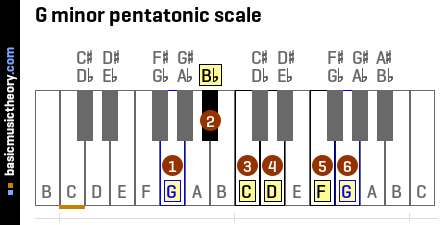
Middle C (midi note 60) is shown with an orange line under the 2nd note on the piano diagram.
These note names are shown below on the treble clef followed by the bass clef.
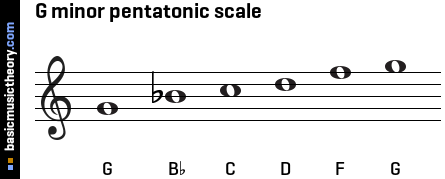
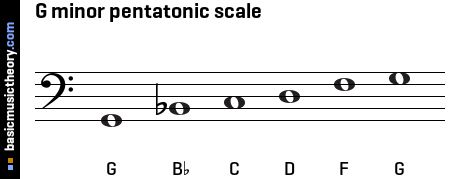
 Bass Clef
Bass Clef
 Treble Clef
Treble Clef
Lesson steps
1. Piano key note names
The white keys are named using the alphabetic letters A, B, C, D, E, F, and G, which is a pattern that repeats up the piano keyboard.
Every white or black key could have a flat(b) or sharp(#) accidental name, depending on how that note is used. In a later step, if sharp or flat notes are used, the exact accidental names will be chosen.
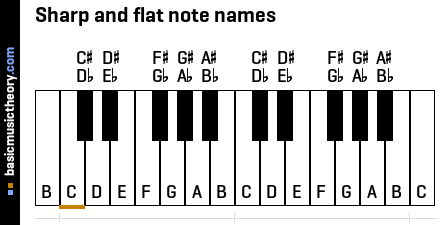
The audio files below play every note shown on the piano above, so middle C (marked with an orange line at the bottom) is the 2nd note heard.
 Bass Clef
Bass Clef
 Treble Clef
Treble Clef
2. G tonic note and one octave of notes
The numbered notes are those that might be used when building this note scale.
Note 1 is the tonic note - the starting note - G, and note 13 is the same note name but one octave higher.
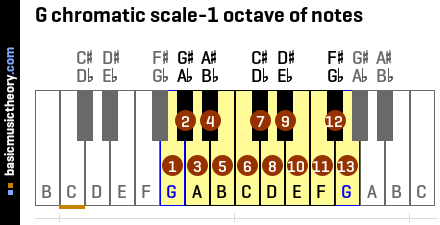
| No. | 1 | 2 | 3 | 4 | 5 | 6 | 7 | 8 | 9 | 10 | 11 | 12 | 13 |
|---|---|---|---|---|---|---|---|---|---|---|---|---|---|
| Note | G | G# / Ab | A | A# / Bb | B | C | C# / Db | D | D# / Eb | E | F | F# / Gb | G |
 Bass Clef
Bass Clef
 Treble Clef
Treble Clef
3. G minor scale note positions
The natural minor scale uses the W-H-W-W-H-W-W note counting rule to identify the scale note positions.
To count up a Whole tone, count up by two physical piano keys, either white or black.
To count up a Half-tone (semitone), count up from the last note up by one physical piano key, either white or black.
The tonic note (shown as *) is the starting point and is always the 1st note in the minor scale.

| No. | 1 | 2 | 3 | 4 | 5 | 6 | 7 | 8 |
|---|---|---|---|---|---|---|---|---|
| Note | G | A | A# / Bb | C | D | D# / Eb | F | G |
 Bass Clef
Bass Clef
 Treble Clef
Treble Clef
4. G minor scale notes
Having identified the piano keys that make up this minor scale, this step shows the note names of those keys.
| No. | 1 | 2 | 3 | 4 | 5 | 6 | 7 | 8 |
|---|---|---|---|---|---|---|---|---|
| Note | G | A | Bb | C | D | Eb | F | G |
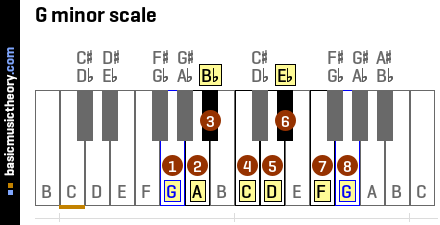
To understand the music theory behind why these sharp and flat note names have chosen given the note positions from the previous step, have a look at the G natural minor scale.
 Bass Clef
Bass Clef
 Treble Clef
Treble Clef
5. G minor pentatonic scale notes
The minor pentatonic scale is made from the 1st, 3rd, 4th, 5th and 7th notes from the natural minor scale above. The 2nd and 6th notes of the minor scale are not used.
Below are those notes numbered 1 to 5 on the piano keyboard.
The 6th note is the octave of the tonic note, where this scale pattern begins to repeat itself up the piano keyboard.
Wherever possible, complex note names from the minor scale are simplified to arrive at the final pentatonic scale notes.
For example, in the Db minor pentatonic scale, the 4th note of the natural minor scale Fb is simplified to be note E.
| No. | 1 | 2 | 3 | 4 | 5 | 6 |
|---|---|---|---|---|---|---|
| Note | G | Bb | C | D | F | G |

 Bass Clef
Bass Clef
 Treble Clef
Treble Clef
Related Keys and Topics
| Key | A | E | B | F# | C# | G# | D# | A# | D | [G] | C | F | Bb | Eb | Ab |
|---|